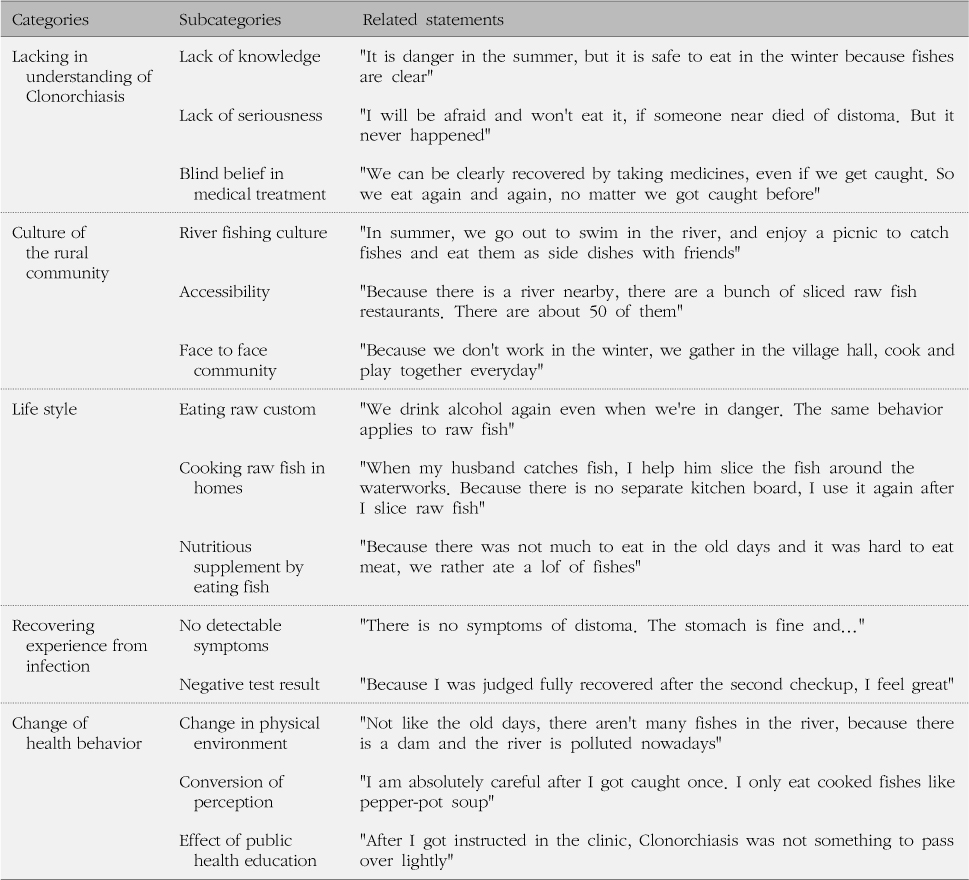Articles
- Page Path
- HOME > J Korean Acad Community Health Nurs > Volume 21(1); 2010 > Article
-
Original Article
- Clonorchis Sinensis Infection Experience in Residents Living in Riverside Areas
- Hee-Gerl Kim, Kyung-Ja June, Souk-Young Kim, Myungsook Park, Chunmi Kim
-
Journal of Korean Academy of Community Health Nursing 2014;21(1):110-117.
DOI: https://doi.org/10.12799/jkachn.2010.21.1.110
Published online: April 4, 2014
1Professor, Department of Nursing, Kyungwon University, Korea.
2Professor, Department of Nursing, Soonchunhyang University, Korea.
3Assistant Professor, College of Nursing, Eulji University, Korea.
4Full-time Lecturer, Department of Nursing, Honam University, Korea.
5Associate Professor, Department of Nursing, Sunmoon University, Korea.
• Received: January 15, 2010 • Revised: March 11, 2010 • Accepted: March 11, 2010
© 2010 Korean Academy of Community Health Nursing
This is an Open Access article distributed under the terms of the Creative Commons Attribution Non-Commercial License (http://creativecommons.org/licenses/by-nc/3.0/) which permits unrestricted non-commercial use, distribution, and reproduction in any medium, provided the original work is properly cited.
- 523 Views
- 0 Download
- 5 Crossref
Abstract
-
Purpose
- The purpose of this research was to describe clonorchis sinensis infection experience in high risk populations living in riverside areas. The research question was "How do local residents perceive Clonorchiasis and how are they infected with the parasite".
-
Methods
- Qualitative data were collected by focus group interviews with 16 participants from January to February, 2009. All the interviews were tape-recorded, transcribed, and analyzed by the content analysis method.
-
Results
- Five main categories were conceptualized, which were "lacking in understanding of Clonorchiasis," "culture of the rural community," "life style," "recovering experience from infection" and "change of health behavior."
-
Conclusion
- The result of this study indicates that residents are infected with Clonorchiasis through interaction between individual and group risky factors. Therefore, it is important to develop effective health education programs on both individual and group levels to prevent infection with Clonorchiasis.
- 1. Jung HY, Park JY, Kim HW, Kim ML, Park ES, Jeong IS, et al. Study on the prevalence and related factors of Clonorchiasis for high risk population at Yeongsangang (Riv) area. J Korean Acad Rural Health Nurs. 2009;4(1):22–30.
- 2. Ju JY, Jung DI, Kong HH, Oak MS. Human parasitology. Daegu: Keimyung University Press; 2003.
- 3. Ju YH, Oh JK, Kong HJ, Sohn WM, Kim JI, Jung KY, et al. Epidemiologic study of Clonorchis Sinensis infestation in a rural area of Kyongsangnam-do, South Korea. J Prev Med Public Health. 2005;38(4):425–430.
- 4. Kim DC, Lee JS, Kim TS, Chang YM, Son SC, Lee OY. Epidemiology of Clonorchiasis : Endemicity of Clonorchis Sinensis, in Sancheong area of upper Nagdong River. Rep Natl Ins Health. 1984;21:267–286.
- 5. Kim HG, Kang HK, So AY, Kim YS, Park JI, Tak KS, et al. A study on the prevalence and related factors of Clornorchis Sinensis for high risk population at Hangang riverside area. J Korean Acad Rural Health Nurs. 2009;4(1):13–21.
- 6. Kim SI, Oh KJ, Park H. A Seroepidemiological survey for human Clonorchiasis on Soonchang-gun near the Sumjin River in Korea. Korean J Rural Med. 2002;27(2):27–33.
- 7. Kim SJ, Kim WJ, Lee KJ, Lee SO. Focus group methods. Seoul: Hyunmoonsa; 2000.
- 8. Kim SI, Yun WS. Control of human Clonorchiasis at Gokseong-gun and Sunchang-gun near the Sumjin River in Korea. Korean J Rural Med. 2004;29(1):163–175.
- 9. Korean Centers for Disease Control and Prevention. Korea Association of Health Promotion. Prevalence of intestinal parasitic infection in Korea-The Seventh Report. Seoul: Korean Centers for Disease Control and Prevention, Korea Association of Health Promotion; 2004.
- 10. Lee GS. Prevalence of Clonorchiasis and its related factors among the inhabitants in Okcheon-gun, Korea. Daejeon: Chungnam National University; 2008. Unpublished doctoral dissertation.
- 11. Morgan DL. Focus groups as qualitative research. Sage Publication, Inc; 2007.
- 12. Morse JM, Field PA. Qualitative research methods for health professionals. London: Chapman & Hall; 1995.
- 13. Park DS. Current status of Clonorchis Sinensis infestation and its related factors among the residence of rural communities. J Korean Acad Rural Health Nurs. 2007;2(1):33–42.
- 14. Park JY, June KJ, Park DS, Jho KN, Jho JS, Kim SC, et al. Prevalence of Clonorchiasis, knowledge and intention to change behavior of village people living in the catchment area of community health posts along the Geum River. J Korean Acad Rural Health Nurs. 2009;4(1):5–12.
- 15. Patton MQ. How to use qualitative methods in evaluation. Newbury Park London New Delhi: Sage Publication; 1987.
Figure & Data
References
Citations
Citations to this article as recorded by 

- Development of tailored contents of a mobile health application to prevent the metabolic syndrome
Jiye Kim, Jiwan Kang, Harim Kim, Juyeun Ko, Hyekyeong Kim, Yuri Kim, Kwangsuk Ko, Minsoo Lee
Korean Journal of Health Education and Promotion.2018; 35(3): 25. CrossRef - A new method for estimating the prevalence of clonorchiasis in Korea
Jin-Young Jeong, Jin Yong Lee, Byung-Suk Chung, Younghyun Choi, Allison Baer Alley, Hyun Joo Kim
Medicine.2017; 96(13): e6536. CrossRef - Prevalence and Related Factors of Clonorchiasis among Five Major Riverside Residents in South Korea
Chunmi Kim, Kyung Ja June, Shin Hyeong Cho, Kyung Soon Park, Hung Sa Lee, Ji Yeon Park
Journal of Korean Academy of Community Health Nursing.2016; 27(4): 346. CrossRef - The Effects of Case Management for Clients with Clonorchiasis in Riverside Areas
Chunmi Kim, Hee-Gerl Kim, Kyung-Ja June, Souk-Young Kim
Journal of Korean Academy of Community Health Nursing.2012; 23(4): 427. CrossRef - A Study on the Prevalence of Clonorchis Sinensis and the Effects of Educational Program among Residents in the Basin of the Youngsan River, Korea
Chunmi Kim, Aeyoung So, Kyung-Ja June, Hee Young Jung
Journal of Korean Academy of Community Health Nursing.2011; 22(1): 56. CrossRef

 KACHN
KACHN

 PubReader
PubReader Cite
Cite

